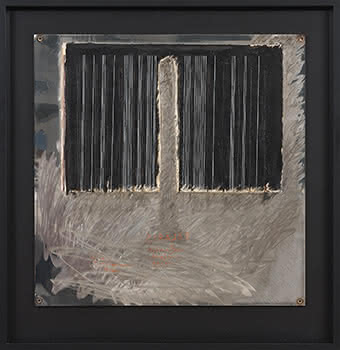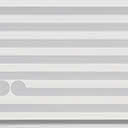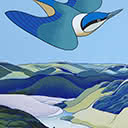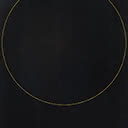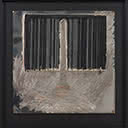Port Chalmers - Polaris, 1983
70 x 70 cm
est. $65,000 - 95,000
PROVENANCE
Private Collection, Taupo
Hotere began the Polaris series in 1962 when he was living in Vence, France and the Cold War was at its height in Cuba. In July of that year, Soviet premier Nikita Khrushchev located nuclear missiles near Havana as a deterrent to American invasion. In retaliation, the US Navy deployed five submarines in the North Atlantic. Each was equipped with 16 Polaris missiles, representing more than 40 times the destructive power of the bombs dropped on Hiroshima and Nagasaki. Twenty years later, with the visit to Auckland of the nuclear-powered frigate USS Texas, Hotere revived his Polaris series as a vehicle for anti-nuclear sentiments. The word POLARIS is mirrored in the text on the painting and combined with portentous references to George Orwell's dystopian novel Nineteen Eighty-Four. Published in 1949, Orwell's book envisions a future in which much of the world is in a state of perpetual conflict and populations are subjected to mass surveillance. After 1984, the political landscape in New Zealand changed, as did nuclear technology. The UGM-27 Polaris missile was the first submarine-launched missile (SLBM) and was deployed from 1961 until 1980. While the Muldoon-led National government supported visits from nuclear-capable vessels sent by treaty partners in ANZUS, the New Zealand public was not so keen. Protestors took to the streets in New Zealand's main centres - opinion polls showed that between 1978 and 1983 opposition to nuclear-armed ship visits had risen from 32% to 72%. A snap election was called when National MP Marilyn Waring told Muldoon that she would not support his government in the vote against an opposition-sponsored anti-nuclear bill. Elected Prime Minister in July 1984, David Lange banned nuclear-powered or nuclear-armed ships from using New Zealand ports or entering New Zealand waters commenting that there's only one thing worse than being incinerated by your enemies, and that's being incinerated by your friends. Hotere shows tension building over the anti-nuclear issue with the parallel vertical white lines massing on a blackpainted paper support. These are interspersed with black verticals gouged out of the paper and then painted over. The paper has been collaged over the top two-thirds of a stainless-steel square with bolt holes in the corners, indicating the material's origin as a base plate from an oven manufactured at the Fisher & Paykel factory in Mosgiel. Working over the steel plate's surface with an angle grinder, Hotere destroys the reflectiveness of the material and at the same time simulates the energy of brush strokes, embedding them in the work. The resultant explosion of scuffs and abrasions is an effective metaphor for the destruction caused by nuclear weapons. Newspaper and television images of the Polaris missile showed it erect on the launch pad at Cape Canaveral, ready for testing. By scraping away the paper at the centre of the work and grinding the surface beneath, he has left the phallus shape of the missile as a negative detail of darker grey at the centre of the composition, a sinister warning of the consequences of nuclear war.
LINDA TYLER

